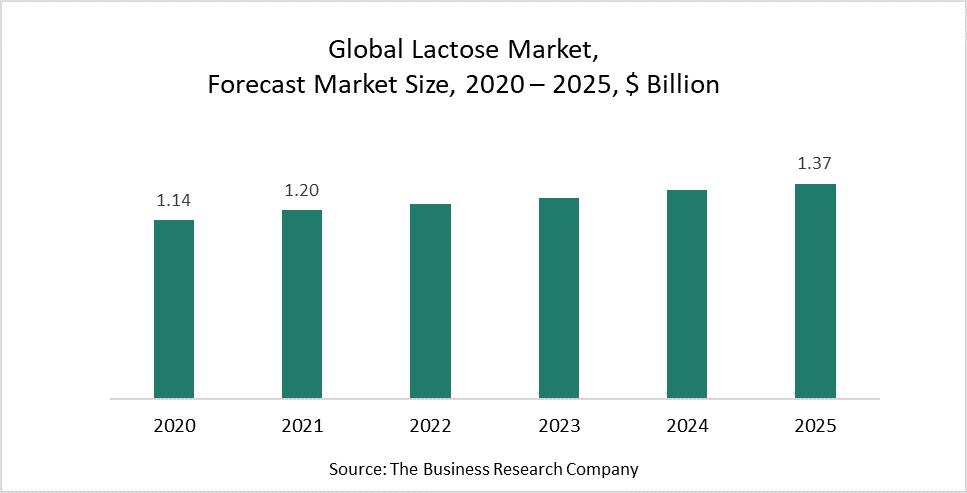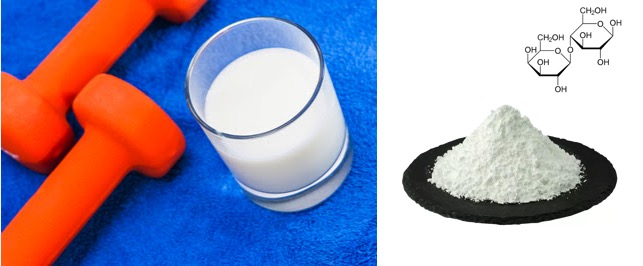The rising demand for sports nutrition products is expected to fuel the lactose market growth. Sports nutrition items are meant to help athletes improve their performance, support muscular growth, and/or aid recuperation after a workout. They can be protein-based or contain other basic ingredients and are available in a variety of forms, such as snack bars, shakes, or powders.
Lactose is an essential ingredient in sports drinks owing to its clinically proven benefits and physical properties. For instance, according to Tate & Lyle, a UK-based supplier of food and beverage ingredients to industrial markets, the global sports nutrition retail value reached $21.6 billion in 2019. Therefore, the increasing demand for sports nutrition products propels the growth of the lactose market.

The global lactose market size is expected to grow from $1.14 billion in 2020 to $1.20 billion in 2021 at a compound annual growth rate (CAGR) of 5.6%. The change in the growth trend of the lactose market is mainly due to the companies resuming their operations and adapting to the new normal while recovering from the COVID-19 impact, which had earlier led to restrictive containment measures involving social distancing, remote working, and the closure of commercial activities that resulted in operational challenges. The lactose market is expected to reach $1.37 billion in 2025 at a CAGR of 3.3%.
Strategic collaborations are a key trend gaining popularity in the lactose market. Major companies operating in the lactose sector are focused on strategic collaborations to expand their product portfolio. For instance, in March 2019, Lactalis, a France-based dairy products corporation collaborated with Prabhat Dairy, India-based integrated milk and dairy products company to enhance its portfolio of dairy products in India. Additionally, in July 2019, Lactalis acquired Itambé, a Brazil-based dairy company. Through this acquisition, Lactalis plans to expand its capacity and process 2.3 billion liters of milk a year in Brazil.
Major players covered in the global lactose industry are Kerry Group, Saputo Inc., Lactalis Ingredients, Leprino Foods Company, Glanbia Plc, Lactose India Limited, Davisco Foods International Inc., DMK Deutsches Milchkontor GmbH, Molkerei MEGGLE Wasserburg GmbH & Co. KG, Royal FrieslandCampina, FrieslandCampina, Armor Proteines, Bayerische Milchindustrie eG, Milei GmbH, Fonterra Co-operative Group, and Agropur Cooperative.
TBRC’s global lactose market report is segmented by form into powder, granule, by purity into crude lactose, edible lactose, refined-edible grade lactose, by color into yellow, pale-yellow to white, white, by end-use into food and beverages, confectionery, animal feed, pharmaceutical, cosmetics, others.
Lactose Global Market Report 2021 – By Form (Powder, Granule), By Purity (Crude Lactose, Edible Lactose, Refined-Edible Grade Lactose), By Color (Yellow, Pale-Yellow To White, White), By End-Use (Food And Beverages, Confectionery, Animal Feed, Pharmaceutical, Cosmetics), COVID-19 Growth And Change is one of a series of new reports from The Business Research Company that provides lactose market overview, forecast lactose market size and growth for the whole market, lactose market segments, and geographies, lactose market trends, lactose market drivers, restraints, leading competitors’ revenues, profiles, and market shares.
The Business Research Company is a market research and intelligence firm that excels in company, market, and consumer research. It has over 200 research professionals at its offices in India, the UK and the US, as well a network of trained researchers globally. It has specialist consultants in a wide range of industries including manufacturing, healthcare, financial services and technology.
Source : November 8, 2021 /EIN Presswire.com

